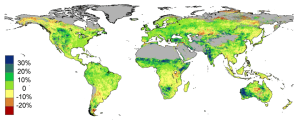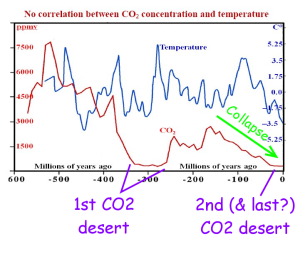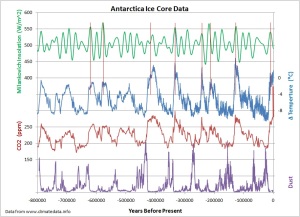Two apparently contradictory headlines caught my attention today:
- Some types of trees may make climate change worse, not better
- Forestry practices have negative climate effects, researchers say
To which my response was “of course trees cause climate change” – that is to say real climate change (not what the copy-n-paste journalists call “climate change”).
So, I’m going to take the chance to summarise my current thinking about the causes of global climate change. So, I’ll start with my own response to the above article:
“of course trees cause climate change”
To explain lets look at the massive changes seen of CO2 levels in the geological record seen below. Because for the last 150 million years we’ve been slowly sliding into another “CO2 desert”. And this period roughly corresponds to the since we’ve seen modern trees and (slightly older) conifers. And it also seems this “CO2” desert could be connected with the onset our modern ice-age cycle.
And this period roughly corresponds to the since we’ve seen modern trees and (slightly older) conifers. And it also seems this “CO2” desert could be connected with the onset our modern ice-age cycle.
How vegetations causes (Real) climate change
Vegetation is in climatic terms, simply a way of drawing up and storing H2O and then transferring it to the atmosphere. Without vegetation, this water would either be locked underground (in arid areas) or quickly run off (in wetter areas). In effect, vegetation is just a way of hugely increasing the evaporative area – and as everyone knows, evaporation causes local cooling. It therefore follows, that in regions where the evaporative area is reduced by cutting down large evaporators (like trees), the temperature will increase in a step-wise form.
But in addition, the local evaporation will decrease – this means that less water enters the atmosphere and consequently (downwind) there is less rainfall and in those areas less vegetation – and with less vegetation, there is less evaporation – so these areas will also see local warming.
Of course – vegetation has very little need for this evaporation and if it could do without it it would. Instead, evaporation is the curse of the CO2 absorber – because plants need wet membranes to absorb CO2. For in order to absorb CO2, the CO2 needs to be absorbed by water in the plant – but to have moist membranes exposed to the atmosphere inevitably means that in gaining necessary CO2, the plant will inevitably lose H2O. So, its a painful trade-off.
No H2O loss – no CO2 gain.
This is why rising CO2 is having the greatest impact in the arid areas: because in non-arid areas, the problem is much less, but in arid areas it means plants need less H2O-loosing surface area in order to gain the necessary CO2 for building plant structure.
How changing vegetation changes the atmosphere
It’s well known that photosynthesising plants are the single reason why our former CO2 rich planet had the “catastrophic” climate change that created the modern O2 rich planet. But as the first graph of CO2 shows, we’ve also seen some pretty odd behaviour in terms of the calculated amounts of CO2 over billions of years.
Recently a theory had grown that plants evolved Lignin and that because fungus were unable to decompose this fungus, that it started to accumulate. Recently a paper has thrown a spanner in that theory by showing that there is just too little accumulated carbon (aka coal) in the ground and that the required fungi were present before the carbon started accumulating.
Delayed fungal evolution did not cause the Paleozoic peak in coal production
The Carboniferous−Permian marks the greatest coal-forming interval in Earth’s history, contributing to glaciation and uniquely high oxygen concentrations at the time and fueling the modern Industrial Revolution. This peak in coal deposition is frequently attributed to an evolutionary lag between plant synthesis of the recalcitrant biopolymer lignin and fungal capacities for lignin degradation, resulting in massive accumulation of plant debris. Here, we demonstrate that lignin was of secondary importance in many floras and that shifts in lignin abundance had no obvious impact on coal formation. Evidence for lignin degradation—including fungal—was ubiquitous, and absence of lignin decay would have profoundly disrupted the carbon cycle. Instead, coal accumulation patterns implicate a unique combination of climate and tectonics during Pangea formation.
source
However, whilst I (now) think it unlikely that lignin was the sole cause of the carboniferous coal deposits and the massive reduction in CO2 levels, it does still seem likely that in some way plant & fungal evolution in some way contributed to the sudden appearance of massive deposits of fossil carbon. Perhaps the explanation is something very simple: in some specific environments (waterlogged?) there was an evolutionary gap so that nothing could unlock the carbon causing accumulation. Perhaps it was just that Lignin SLOWED down the decomposition of plant material – such that in areas already problematic like waterlogged environments, the evolution of lignin tipped the balance toward accumulation (also increased plant growth would explain the same).
This evolutionary gap, therefore explains not only why the carbon started to accumulate, but also why eventually we stopped seeing massive accumulation (as new-faster decomposes evolved). But also, we cannot exclude the possibility that in some way a change in climate (or indeed location of continents as they wonder) caused a wetter-period, which ALWAYS causes accumulation, but it’s just that only when the climate swings to wetter (…& ?) do we start getting carbon being locked up and the formation of these CO2 deserts.
The modern CO2 desert?
Which brings me to the biggest question (or second biggest question after what causes ice-age cycle) in climate: “what caused/is causing the collapse in CO2 levels.
Discarding the “bottle” view of the atmosphere.
If you read anything written by academia about the atmosphere, the re is one underlying assertion:
re is one underlying assertion:
the atmosphere is completely bounded and is incapable of growing or shrinking in size (except by the almost negligible emission of some gases like Hydrogen into space over very long geological periods).
Thus we have the modern concept of the atmosphere. Every molecule has been there and will be there for ever and ever and nothing (except “evil” industry) causes it to change. Of course, by their own theories about CO2 build up, this is bollocks. But the basic principle remains:
atmospheric pressure does not change
(false)

Model of carboniferous dragon fly showing how much larger flying insects were (all insects were larger)
Source: http://scienceray.com/biology/higher-oxygen-levels-rear-giant-dragonfly/
Except this is good circumstantial evidence it does! Look at the dragonfly to the right. This is a massive thing. (Only) four things can explain it:
- Greater oxygen levels and higher metabolic rates
- No bigger predators so there was a niche for a larger sized (albeit less efficient) dragonfly.
- The atmospheric pressure was much higher – so closer to swimming in water and more bouyant.
- Humans have shrunk 🙂
Ok, I just like the picture. The fact that we see larger insects may indicate a higher atmospheric pressure. Better evidence comes from the changing composition of the atmosphere – which shows that the atmosphere is far from closed in terms of being “consumed” by geology and being similarly emitted by it.
Of course pressure changes
Obviously if CO2 levels increase – by the change of O2 + C-> CO2, the average weight of molecules will change and hence pressure will change. But also there are many many chemical processes that lock up O2 and CO2. For example rusting is a wonderful process for absorbing O2 – and as almost all the iron ore deposits (and the brown colour of the earth) are due to iron oxides, it means that there has been a massive locking up of O2. But similarly (modern?) plants & bacteria lock up nitrogen. And through various chemical processes the nitrates in the soil can be locked up in the geology.
The alternative view of the atmosphere
So, let me propose an alternative view of the atmosphere:
The atmosphere (over geological periods) is constantly being locked up through a variety of chemical processes so that it tends toward zero pressure (much like the moon/Mars). And, it is only because there is a geological cycle that constantly emits these atmospheric gases that we have our atmosphere.
A reinterpretation of the CO2 deserts
If, this is true, then rather than assuming the atmosphere is constant – we must assume that it is constantly “leaking away” into our geology. And as such, the biggest influence cause change would be the emission of gases – not the absorption, which we expect to be fairly constant (Note – I suspect both are changing, but let’s just flip the “consensus” on its head and see where this gets).
So, now, we have a model where:
- Gases are constantly leaking away into geology
- Gases are being spasmodically re-introduced through volcanic acitivity
- Atmospheric constituents and overall pressure respond to rates of emissions.
 If in addition we assume that CO2 absorption and accumulation by plants is a constant – we now can see that rising CO2 represents a dramatic increase in CO2 emissions, and that periods of reduction represent periods of low emissions.
If in addition we assume that CO2 absorption and accumulation by plants is a constant – we now can see that rising CO2 represents a dramatic increase in CO2 emissions, and that periods of reduction represent periods of low emissions.
This now explains the rather odd shape of the CO2 curve: a general downward slope with a series of sharp increases (250million years ago – corresponding to a period of massive volcanic activity) and 160million years ago (?).
But where is the temperature rise?
Unfortunately, there is a massive problem with the above model. Because as I have explained, the greenhouse effect of the atmosphere is largely dependant on the atmospheric pressure (and to a lesser extend the relative constituents). And, if rising CO2 represented a period of massive emissions of gases into the atmosphere, then we would expect to see rising temperatures – and as the above graph shows there’s little to suggest this occurred.
…. but hang on a minute!!! Have you any idea how this “temperature” graph was compiled. The above graph is so ubiquitous on the internet that it’s now impossible to (readily) track down its source. But looking elsewhere I cannot see any obvious way to reliably measure temperature. Because how could you? Even if you could find some geological process which is sensitive to surrounding temperature – over these timescales, that “place” because of tectonic plate movement, wonders around the planet experiencing different temperature regimes.
So, all anyone can really say is that: IN THOSE AREAS where rock is being laid down, that the processes tend to represent those of a warmer/cooler LOCAL climate. So, one period may be seen as “warm” only because rocks from that period HAPPEN to come from areas that were warmer than average and vica versa with colder periods.
CO2 as a proxy for pressure in the ice-age cycle:
So, I’ve shown that there is no good reason to reject the purely geological explanation for rising and falling CO2 – as a proxy for atmospheric pressure. And this remains a real possibility to explain the ice-age cycle, where if we now view CO2 & temperate as shown right, they rise and fall together (with a slight lag).
Now this can be interpreted as CO2 being a proxy for pressure and so we have:
rising CO2 → (is proxy for) → rising pressure → rising temperature
Quick review of Catapillar theory of ice-ages

Thanks Josh cartoonsbyjosh.com
The caterpillar theory is based on the simple proven physics that rock expands when heated and shrinks when cooled. Therefore, the ice-age cycle causes rocks to repeated expand and contract, and it proposes that this causes mantel to be subducted when heated – which then causes the rock to be thermally decomposed emitting gases.
Several mechanisms could explain how this feeds back into rising temperature. CO2 alone is a non-started as its effect is minuscule. But CO2 could trigger plant growth which then caused evaporation and cloud formation causing massive changes. But another possibility is that volcanic gases literally massively increased pressure and that in itself created an increased greenhouse effect.
Back to trees (& snails)
Whilst volcanic emissions are undoubtedly important and no doubt much of change we see in the atmosphere is a result of changes in volcanic activity, we also know that plants have had a massive impact on climate.
The big question that is currently bugging me, is where is all this CO2 being locked up? We know that even though humans are burning massive amounts of geological carbon, the quantity of CO2 we emit is minuscule compared to natural processes. So, whilst we may have had a small effect on CO2 levels, the real culprit for the current level (i.e. CO2 desert) are the plants or perhaps some kind of chemical process locking it into carbonates and then into rocks? – Indeed, the other big “culprit” may be those darned snails! Stealing our carbon, and refusing to recycle OUR CARBON.
But – there is far far more carbonate than carbon in the earth. So, by far the most likely place for locking up CO2 is in carbonate rocks (& limestones -via those snails).
Blaming the peat
My intention when I started thinking about this was to somehow link recent drops in CO2 with the evolution of peat. To suggest that peat growth was locking up massive amounts of carbon and may be in some way implicated with the “theft” of CO2 from the atmosphere. As such, again, we might envisage the evolution of a particular kind of “moss” that is somehow largely responsible for the growth of peat bogs. So, rather than peat being a passive effect of climate change, now peat is actively changing the atmospheric composition (and perhaps even by out-competing trees possibly also changing the climate itself!) That is to say, because peat “locks up” the water – it somehow stops evaporation – the local area becomes warmer – and hence (globally) causes modest warming!
Summary
So, finally let’s just summarise these ideas:
- Trees can and do directly change the climate. Indeed, Tree loss & then progressively less vegetation is just another way of saying “urban heating”.
- We can’t easily explain the first CO2 desert. The evolution of lignin is strongly implicated but the mechanism remains unclear.
- We can’t explain the second CO2 desert using similar evolutionary change. My only candidate so far is peat.
- We could explain the change if e.g. Snails were now locking up more CO2 (corral reefs?) But I’ve not seen anything to suggest an evolution change here (but that could easily be lack of knowledge).
- Geological processes that absorb atmospheric gases tend to be widespread surface phenomenon. As such they tend to be pretty constant. So it’s difficult to see how the rate of absorption could change.
- Geological processes that emit gases can be sporadic. There can be large volcanic events emitting vast amounts of gas. However, such events would also cause atmospheric pressure to change.
- Geological processes (or meteorites) which have a dramatic effect on plants/animals and so disrupt the accumulation over a relatively short period.
Conclusion
There are two alternative types of explanations for the changes in CO2 levels. The first are that of evolution of new species. The second is that spasmodic geological processes are emitting gases (and also very likely changing total atmospheric pressure).
There are few candidates to explain the evolution of the current “CO2 desert” – which also explain the collapse of the last “CO2 desert”. It therefore seems most likely that the “change” that occurred, was not that something is locking up more carbon now, but that something caused a massive introduction of CO2 (and other gases) in the past. So, whilst evolution is undoubtedly important, it probably causes a gradual change in the rate of accumulation.



I really enjoyed reading this post. A balanced, reasoned script that it looking to explain what changes climate. Any reader will KNOW the culprit is not man, and will also see the need for more CO2. This real science fascinates; it is refreshing from the media driven drivel we normally are subject to.
Thanks for posting it.
Thanks – yes the real science is very interesting and “manmade” warming is not only incorrect but boring.
Agree with Nigel, thanks for this post. Very thought provoking.
Don’t forget about the out-gassing of CO2 from the oceans (and also absorption), which AFAIK is estimated at a higher tonnage than land sources and sinks.
Interesting…
I imagine the greater size of the insects was a result of increase in oxygen levels, as they breathe via tracheae, which limits the size.
The fundamental relationship is that there is more oxygen per unit of “lift”. Barring changes in gravitational field, that suggests either that there was more oxygen in each unit of atmosphere and/or that the air was more dense.
If the air is more dense, (with same % oxygen), then not only is there more oxygen per unit of atmosphere, but also more lift.
However, if let’s say we assume that just the percentage of oxygen changed – this means either that oxygen is added to the atmosphere – or that e.g. nitrogen is removed. Either way, we are talking about a massive millions of year pressure change.
This is why I am increasingly tending toward the view, that the earth’s pressure is as highly variable as e.g. CO2 levels or O2.
Pingback: A complete explanation of the ice-age cycle. | Scottish Sceptic